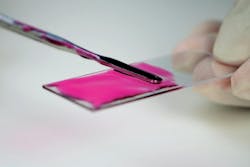One Part Epoxy Changes from Red to Clear Under UV Light
Master Bond UV15RCL is a low viscosity, cationic type UV curing system with a special color changing feature. The originally red material changes to clear once exposed to UV light, indicating that there is UV light access across the adhesive material. Although this change in color from red to clear does not indicate a full cure it does confirm that the UV light has reached the polymer. By giving immediate visual feedback UV15RCL offers processing and handling advantages over conventional systems. Curing under UV light typically takes 30-60 seconds with a broad-spectrum UV lamp emitting light with a wavelength range between 320-365 nm. The minimum energy required is 20-40 milliwatts per cm2.
UV15RCL features a high glass transition temperature (Tg) of 90-95°C. However, when post cured for 1-2 hours at 125°C, the Tg can increase to 125-130°C. It has a service temperature range from -80°F to +350°F. This non-solvent based system cures tack free and has a very low viscosity of 115-350 cps, making it ideal for spin coating. It is not oxygen inhibited and provides light transmission properties and good optical clarity, with a refractive index of 1.517. Also, it is an excellent electrical insulator with a volume resistivity exceeding 1014 ohm-cm.
UV15RCL is suitable for bonding and sealing applications as it adheres well to metals, glass, ceramics and many plastics, including acrylics and polycarbonates. It is available in a wide range of packaging options, including syringes, ½ pint, pint, quart and gallon containers.
